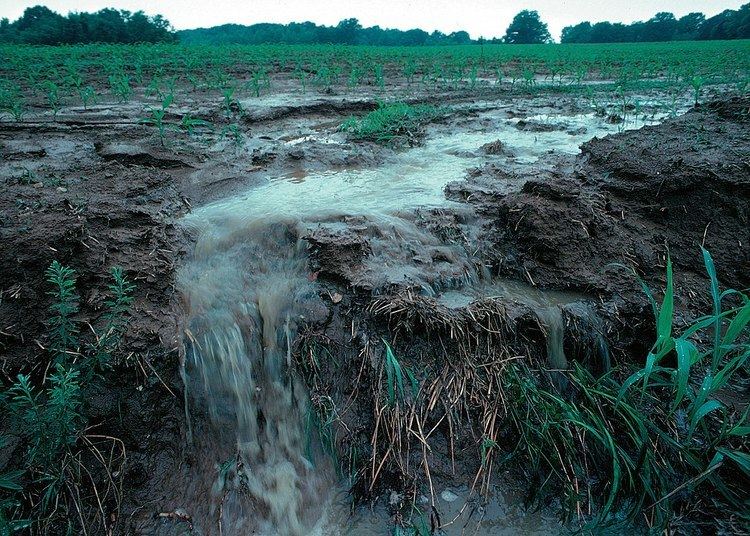 | ||
Topsoil is the upper, outermost layer of soil, usually the top 2 inches (5.1 cm) to 8 inches (20 cm). It has the highest concentration of organic matter and microorganisms and is where most of the Earth's biological soil activity occurs. Four elements constitute the composition of soil. Those elements are mineral particles, organic matter, water, and air. The volume of top soil consists of 50 to 80 percent of these particles which form the skeletal structure of most soils. This composition allows the soil to sustain its own weight, and other internal matter such as water and overlying landscape. Organic matter, another important element, varies on quantity on different soils. This provokes positive and negative effects or reactions on the soil. The strength of soil structure decreases with the presence of organic matter, creating weak bearing capacities. Organic matter condenses and settles in different ways under certain conditions, such as roadbeds and foundations. The skeletal structure becomes affected once the soil is dewatered. The soil's volume substantially decreases. It decomposes and suffers wind erosion.
Contents
Importance
Plants generally concentrate their roots in and obtain most of their vital nutrients from this layer. Actual depth of the topsoil layer can be measured as the depth from the surface to the first densely packed soil layer known as subsoil.
Classification
In soil classification systems, topsoil is known as the "O Horizon or A Horizon," therefore, it is the very top layer.
Commercially available topsoil (manufactured or naturally occurring) in the United Kingdom should be classified to British Standard BS 3882 with the current version dated 2015. The standard has several classifications of topsoil with the final classification requiring material to meet certain threshold criteria such as Nutrient Content, Extractable Phytotoxic Elements, Particle Size Distribution, Organic Matter Content, Carbon:Nitrogen ratio, Electrical Conductivity, Loss on Ignition, pH, Chemical and Physical Contamination. The topsoil should be sampled in accordance with the British Standard and European Norm BS EN 12579:2013 Soil improvers and growing media - Sampling. During construction of garden areas for housing plots the topsoil should be underlain by a layer of suitably certified subsoil that conforms to the British Standard BS 8601:2013 Specification for subsoil and requirements for use.
It is always recommended that for construction projects that topsoil is placed in accordance with the DEFRA report Construction Code of Practice for the Sustainable Use of Soils on Construction Sites
Evaluation
When starting a gardening project, it is crucial to check whether or not the soil is satisfactory. Different types of plants vary in their nutrient needs and preferred soil conditions, many are strongly adapted to particular conditions. However, some general guidelines for "desired levels of Topsoil nutrients" have been made, broadly suitable for many plants.
The two common types of Topsoil are Bulk and Bagged Topsoil. The following table illustrates major differences between the two.
Alternatively the British Standard relates to other working values:
This is for a multipurpose grade and certain levels can alter with regard to soil pH. Other uses specified in the standard that allows for a variety of uses in different and specific scenarios includes:
Acidic, Calcareous, Low Fertility, Low Fertility Acidic and Low Fertility Calcareous. These uses are limited to specific site scenarios and acceptance should be on a case by case basis for construction projects.
The Carbon Nitrogen Ratio
Topsoil is the primary resource for plants to grow and crops to thrive and the main two parameters for this are Carbon and Nitrogen. The Carbon provides energy and Nitrogen is a tissue builder and plants require them in a range of ratios to enable suitable growth. An optimum figure for Topsoil in the UK is a ratio of less than 20:1. This ensures that the soil has a suitable energy reserve as well as tissue building material to enable the plants to thrive. A sawdust typically has a carbonaceous base and this a high C:N ratio (in the order of c. 400:1) while an Alfalfa Hay has a low carbonaceous content and can typically have a C:N ratio in the order of 12:1.
Commercial application
A variety of soil mixtures are sold commercially as topsoil, usually for use in improving gardens and lawns, e.g. container gardens, potting soil and peat. Another important yet not commonly known use for topsoil is for proper surface grading near residential buildings such as homes. "The ground around the home should slope down six inches for the first ten feet away from the home. This can often be done by adding topsoil (not sand or gravel)."
Erosion
A major environmental concern known as topsoil erosion occurs when the topsoil layer is blown or washed away. Without topsoil, little plant life is possible. The estimated annual costs of public and environmental health losses related to soil erosion exceed $45 billion. Conventional agriculture encourages the depletion of topsoil because the soil must be plowed and replanted each year. Sustainable techniques attempt to slow erosion through the use of cover crops in order to build organic matter in the soil. The United States alone loses almost 3 tons of topsoil per acre per year. This is of great ecological concern as one inch of topsoil can take between 500 and 1,000 years to form naturally. On current trends, the world has about 60 years of topsoil left.
